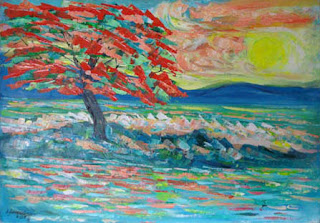José Loreto Horruitiner (1933) asume el paisaje como una expresión concreta. La
estructura de las obras es fuertemente subrayada por gruesas pinceladas que aluden a
un universo matérico afín a su condición colorista. Mantiene vínculos con la vanguardia
plástica que parte de Cézanne y se habla de barroquismo por el abigarramiento de
imágenes, líneas y colores. Su ciudad es la sitiada por el mar Caribe y el amasijo de
figuras describe la irregularidad de la urdimbre urbana. Ella, por el color agresivo, las
formas cúbicas, la luz inmanente, la planimetría de la sintaxis, resulta agresiva, violenta,
dura y agobiante como Santiago de Cuba bajo el sol del verano.
José Loreto Horruitiner (1933) assumes landscape as a concrete expression. The structure of his works is strongly emphasized by thick brush strokes that allude to a universe related to their material status as a colorist. He maintains links to the forefront Cézanne plastic part and talks about baroque by mottling of images, lines and colors. His city is under siege by the Caribbean Sea and the mass of figures described by irregular urban warp. He is defined by the aggressive use of color, the cubic forms, immanent light, the flatness of the syntax, it is aggressive, violent, harsh and oppressive as Santiago de Cuba under the summer sun.
La obra de José Loreto Horruitiner / Samples of Jose Lorero Horruitiner's work:
 |
| Oleo de José Loreto Horruitiner |
 |
| Oleo de José Loreto Horruitiner |
 |
| Oleo de José Loreto Horruitiner |
 |
| Balla de José Loreto Horruitiner |
 |
| Oleo de José Loreto Horruitiner |

No comments:
Post a Comment